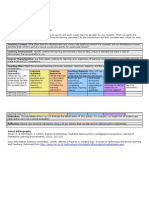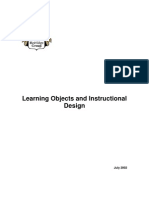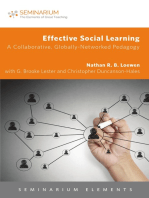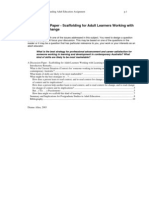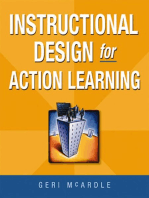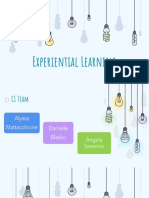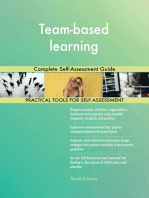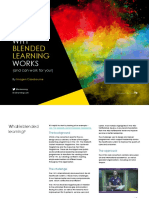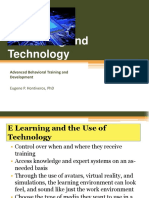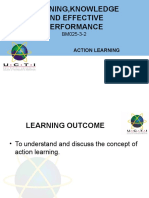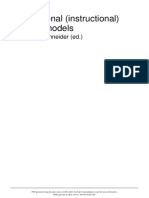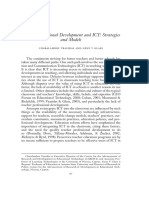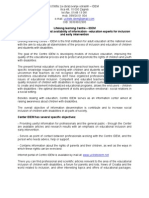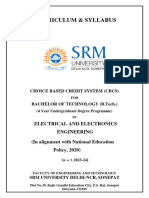Professional Documents
Culture Documents
Microlearning A Strategy For Ongoing Professional Development.
Uploaded by
ibuchemOriginal Title
Copyright
Available Formats
Share this document
Did you find this document useful?
Is this content inappropriate?
Report this DocumentCopyright:
Available Formats
Microlearning A Strategy For Ongoing Professional Development.
Uploaded by
ibuchemCopyright:
Available Formats
Microlearning: a strategy for ongoing
professional development
Ilona Buchem
Beuth, University of Applied Sciences Berlin
Henrike Hamelmann
University of Applied Sciences Munich
Summary
In this paper we introduce microlearning in online communities as a learning approach
triggered by current patterns of media use and supported by new technologies, such Web 2.0
and social software. We delineate microlearning as a ―pragmatic innovation‖ to lifelong learning
due to its capability to support flexible learning that can be easily integrated into everyday
activities, supporting individual learning aims and needs.
First, we explore the concepts of microcontent and microlearning in the context of Web 2.0,
social software, eLearning 2.0, personal learning environments, and informal and work-based
learning, observing its innovative approaches to lifelong learning and reflecting the needs of
current web users. We then identify underlying design principles and distinguish two main
aspects of didactical design, i.e. (1) design of microcontent and (2) design of microlearning
activities. We continue by presenting the ten key features that we identified to help distinguish
microlearning from more traditional eLearning formats, such as web-based trainings, termed
―macrolearning‖.
Following this overview, we illustrate how microlearning can contribute to lifelong learning by
bridging the gap between formal and informal learning and present a case study of a
microlearning scenario. We argue that microcontent and microlearning, enhanced by Web 2.0,
provide a viable solution to fast-paced and multitask-oriented patterns of learning and working
today. Microlearning, aligned with formal learning and embedded in online communities, has
the potential to support ongoing professional development.
Keywords: informal learning, microlearning, microcontent, online communities, Web 2.0
Introduction
Current technological, economic and social changes trigger the need for new concepts and
strategies to support lifelong learning. Education, including work-based learning, is in need of
transformations, requiring renewal and innovative ways of relating appropriately to the way we
live, work and learn today (Downes, 2005; Kuhlmann & Sauter 2008; Chisholm 2005).
eLearning Papers • www.elearningpapers.eu • 1
Nº 21 • September 2010 • ISSN 1887-1542
The terms describing how we work and learn today, such as ―knowledge workers‖ (Tapscott,
2006), ―digital natives‖, ―digital immigrants‖ (Prensky, 2001), ―new millennium learners‖ (OECD,
2006) and the ―Net Generation‖ (Oblinger & Oblinger, 2007), reflect some essential changes in
modern societies, ―where digital technologies form an inextricable part of daily life‖ (OECD,
2006). The way of life of a new generation, i.e. those born from the 1980s onwards, but also of
older generations, is becoming strongly influenced by the Internet and related technologies.
Both younger and older learners take their laptops to classes or work meetings, use mobile
phones and the Web to foster social networks, employ digital devices to play games and create
content, or multitask engaging into different activities at the same time (Roberts, 2007).
Web 2.0 technologies bring about such socio-cultural changes as the ―do-it-yourself-culture‖,
reflected in the grassroots journalism or Open Educational Resources, with individuals
becoming actively involved in co-creation of cultural assets beyond formal structures, changing
from consumers to producers, thus becoming so-called ―prosumers‖ (Toffler, 1980; Bowman &
Willis, 2003; Kuhlmann & Sauter, 2008). These new digital technologies enabling the creation
of user-generated content have given rise to a trend towards microformats, i.e. short, simple
and targeted information (Allsopp, 2007; Masie, 2006). Together with personal publishing
systems, such as blogs or wikis, it has become fairly easy for anyone to create own content,
including microcontent. Microcontent, i.e. ―information published in short form‖, relates more to
―a formal approach of how to present content‖ rather than the inherent quality of the content
itself (Mosel, 2005; Lindner, 2006). Examples of microcontent include podcasts, blogposts, wiki
pages or short messages on Facebook1 or in Twitter2. Creating, publishing and sharing of
microcontent on the Web open up new possibilities for implicit, informal and incidental forms of
learning, such as microlearning, the term referring to short learning activities with microcontent
(Lindner, 2006; Robes, 2009; Hug, 2010).
This paper discusses the concept of microlearning in context of lifelong learning and reports on
a microlearning case study from the research project ―Mediencommunity 2.0‖. Section 2
introduces the concepts of microcontent and microlearning. Section 3 describes key principles
of microlearning design. Section 4 presents the case study and illustrates how microlearning
can help bridge the gap between formal and informal learning. Section 5 concludes with a
reflection on the potential of microlearning for lifelong learning.
Microcontent and Microlearning
Microlearning has evolved due to the need to focus less on new technologies themselves and
more on individual learning needs (Chisholm, 2005; Robes, 2009). Microlearning refers to short
forms of learning and consists of short, fine-grained, inter-connected and loosely-coupled
learning activities with microcontent (Lindner, 2006; Schmidt, 2007). The term ―microlearning‖ is
closely linked to a following concepts:
Microcontent
Web 2.0 and related technologies change the type of information available on the Web
towards small and shorter chunks of content, so-called microcontent, e.g. blog posts, wiki
pages. Microcontent can be described as ―information published in short form, with its
length dictated by the constraint of a single main topic and by the physical and technical
limitations of the software and devices that we use to view digital content today [...] Today,
1
http://www.facebook.com/
2
http://twitter.com/
eLearning Papers • www.elearningpapers.eu • 2
Nº 21 • September 2010 • ISSN 1887-1542
microcontent is being used as a more general term indicating content that conveys one
primary idea or concept, is accessible through a single definitive URL or permalink, and is
appropriately written and formatted for presentation in email clients, web browsers, or on
handheld devices as needed‖ (Dash, 2002). Thus microcontent is an integral part of
microlearning.
Web 2.0
Microlearning in the context of Web 2.0 is viewed as part of a dynamic, open and
fragmented digital environment, in which microchunks of information can be individually
produced, aggregated, used and reused (Lindner, 2006). Microlearning based on Web 2.0
applications is embedded in a complex digital ecosystem comprising ―very small, pieces,
loosely joined, permanently rearranging to form volatile (micro-)knowledge clouds‖
(Lindner, 2006). An important aspect of Web 2.0-based microlearning is active participation
of learners in the process of co-creation and distribution of microcontent.
Social software
Social software may be viewed as a major component of Web 2.0 and can be
characterized by its capability to support social interaction (Schaffert & Hilzensauer, 2008).
Social software brings together learners with different prior knowledge, interests and
learning goals through emergent social practice of social networking, collaborative writing
or social tagging. Microlearning supported by social software enables not only short and
flexible formats or rapid delivery of content, but also social interactions based on that
content. This aspect is also an integral part of online communities, where learners connect
as they create, aggregate, share, use and re-purpose content, including smaller content
chunks.
E-learning 2.0
Microlearning can either take place within emergent microcontent structures such as blogs
or microblogs, or it can take place within a designed setting in form of e-learning (Mosel,
2005). E-learning 2.0 can be described as a new approach to e-learning facilitated by Web
2.0 and social software. Unlike e-learning 1.0 focusing on composing, organizing and
packaging content, E-Learning 2.0 enables learners to syndicate, aggregate, remix and
repurpose content according to individual aims and needs (Downes, 2005). Microlearning
can be viewed as E-Learning 2.0 with microcontent (Lindner, 2006).
Personal Learning Environments
Microlearning activities, especially in context of informal learning, can be integrated into
Personal Learning Environments (PLEs). PLEs can be described as ―a collection of
interoperating applications‖, which enable learners individual access, aggregation,
arrangement, configuration, manipulation, reuse and remix of digital artefacts in an ongoing
learning experience (Downes, 2005; Lubensky, 2006). PLEs in combination with mash-up
technologies enable ―combining existing data and services from several sources‖ within a
single interface (Chatti et al., 2009). In this way PLEs support learners in aggregating small
chunks of content, such as feeds and widgets, in a ―personal learning center‖ by pulling
external content, combining different content units and distributing the result to different
applications (Chatti et al., 2009; Downes, 2005). Microcontent created and used within a
PLE can be easily customized, aggregated and distributed though its permeable boarders.
This allows for a high degree of control over learning, empowering learners with taking
charge of shaping their lifelong learning.
eLearning Papers • www.elearningpapers.eu • 3
Nº 21 • September 2010 • ISSN 1887-1542
Informal Learning
Microlearning is also closely related to informal learning, especially as far as learning
context, degree of structuring and format are concerned (Robes, 2009). Both microlearning
and informal learning take place beyond formalized structured, e.g. within digital,
micromedia environments (Lindner, 2006). Short microlearning activities with a length of a
few seconds up to about 15 minutes and can be easily and flexibly integrated into everyday
activities. Since microlearning does not demand long attention spans and long-time
involvement of the learner, it can be easily used to support on-demand and in-between
learning. Microcontent as input and output of microlearning can be created and used in the
transition from learning communities through communities of practice to learning networks,
bridging the gap between formal and informal learning (Kuhlmann & Sauter, 2008).
Work-based learning
Microlearning is also related to work-based learning with the term ―microtraining‖ used to
describe short work-based training formats (Robes, 2009). Microtraining can be used as a
component of formal blended learning, as means to support informal learning at the
workplace, or as self-contained training (Robes, 2009). As such microlearning can add
value to organizations, as it enables flexible learning and requires less investment in terms
of time and resources. However, the real value-added of microtraining combined with Web
2.0 and social software is its capability to integrate short formats with user-generated
content and social interaction. The recent European Commission report ―New Skills for
New Jobs‖ calls for the need to support flexible learning paths, motivation and individual
learning for successful lifelong learning (EC, 2010). Microlearning offers flexible pathways
to learning, especially in context of work-based learning.
As indicated above microlearning combines different approaches to learning. Microlearning
facilitates self-directed lifelong learning, as short activities can be easily integrated into every-
day activities. Small learning steps with small chunks of information can be used for learning in-
between and on-demand. In this way microlearning enables individuals to stay up-to-date in
today’s knowledge society and offers a viable supplement to more time-consuming and
formalized modes of learning, such as classroom courses or web-based trainings.
The following table provides an overview of 10 differences between microlearning and larger
formats of e-learning in terms of time and scope. To distinguish between these different forms,
the term ―macrolearning‖ is introduced to represent such formats as web-based trainings or
courses delivered via Learning Management Systems (LMS). In general macrolearning
involves more time and larger chunks of content. It is usually based on richer macro-media
formats, such as multimedia learning modules or ample learning materials, e.g. text-based
scripts or power point slides, and demands longer periods of time to be spent on learning
activities, e.g. 1-2 hours. The summary aims at providing a structured overview of differences
between macrolearning and microlearning. We believe that microlearning and macrolearning
both serve different needs and purposes, and thus should be viewed as complementary, and
not as exclusive, forms of e-learning. The following contribution is based on literature review
(Leene, 2002; Lindner, 2006; Robes, 2009; Hug, 2010) and findings from the research project
―Mediencommunity 2.0‖.
eLearning Papers • www.elearningpapers.eu • 4
Nº 21 • September 2010 • ISSN 1887-1542
Macrolearning Microlearning
1 Learning context formal learning informal learning
2 Time spent several hours a few seconds up to about 15
minutes
3 Content type learning modules, comprising and microcontent as small chunks of
structuring a broader range of ideas or information, focusing on a single
topics and combining learning objects definable idea or topic
4 Content creation content created by subject matter content co-created by learners with
experts, usually with authoring tools Web 2.0 and rapid e-learning tools
5 microcontent units are self-contained
learning objects usually need to be
as they can be understood without
Content combined with other learning objects to
any additional information;
aggregation and enable full understanding; content can
microcontent cannot be divided into
fragmentation be easily split for re-use and
smaller pieces without the loss of
restructuring
meaning
6 Content retrieval courses or topics retrievable through a microcontent has a unique URL
unique URL, however single learning (permalink), which make even small
objects are not addressable chunks of information retrievable
7 dynamic, flexible structures created
hierarchic, sequential, pre-planned
by learners in the process of
structures consisting of a number of
Structure of the learning through syndication,
units or lessons, each combining a
learning cycle aggregation and modification, based
number of learning objects, such as
on such data as social tags and
texts, images, audio, video
bookmarks
8 Target group learners aiming at gaining an insight learners aiming at exploring
into topics defined by domain experts concepts or solving practical
problems
9 learners as prosumers of content,
learners as consumers of content,
building own mental structures
Learner’s role attempting to build mental structures
through exploration and social
similar to those of experts
interaction
10 Learner focuses on social interactions
focuses on learner-content interactions
participation between learners
Table 1: Comparing macrolearning and microlearning
Based on these considerations microlearning can be described as a ―pragmatic innovation‖ to
lifelong learning. It is pragmatic, because it is congruent with current information and
communication patterns and can be easily adapted to support individual learning needs,
especially within informal learning contexts. It is innovative, because it offers a new way of
designing and organizing learning, such as learning in small steps and with small units of
content, learner-driven structuring and sequencing, co-creation of content, generating and
using content through social interaction.
Microlearning and Microcontent: Design Principles
Web 2.0, most notably social software and user-generated content, changes the way Internet is
used in general, including learning. The disappearing boundaries between ―users and authors‖,
―local and remote‖, ―public and private‖, transforms didactical design of e-learning (Kerres,
2007). This is reflected in the use of the term E-Learning 2.0:
eLearning Papers • www.elearningpapers.eu • 5
Nº 21 • September 2010 • ISSN 1887-1542
“This approach to learning means that learning content is created and distributed in a very
different manner. Rather than being composed, organized and packaged, e-learning content is
syndicated, much like a blog post or podcast. It is aggregated by students, using their own
personal RSS reader or some similar application. From there, it is remixed and repurposed with
the student's own individual application in mind, the finished product being fed forward to
become fodder for some other student's reading and use.” (Downes, 2005).
In this view new technologies bring the shift in focus of didactical design. The design of E-
Learning 2.0 is more about arranging a stimulating environment in which learning can be
initiated and individually managed by the learner rather than predicting the sequence of
learning steps and precisely planning instruction. An important part of E-Learning 2.0 is
content, which is co-created, modified and used by learners. This user-generated content is not
confined to a particular digital space but is distributed and available both inside and outside of
learning environments. This ―mobility‖ of content across various platforms is supported by its
light format. Microcontent in form of small, loosely-coupled units of digital information can be
easily transported, flexibly arranged and individually aggregated. Didactical design of
microlearning with microcontent focuses on adequate pedagogical strategies and tools
facilitating co-creation and use of content rather than covering a certain scope of content within
a specified amount of time.
Didactical design of microlearning is not only about design of microcontent but it is also about
designing microlearning activities based on microcontent and resulting in microcontent. As such
microlearning raises new questions of didactical design of learning activities (Lindner, 2006).
The small format does not imply simplified pedagogical strategies. On the contrary, designing
microlearning scenarios becomes even more complex, as it integrates various didactical
approaches (Kerres, 2007). Current approaches to microlearning emphasize the role of
permeability of learning environments, aggregation, modification and distribution of
microcontent, personal engagement and contribution, participation in individual and social
learning activities, social group processes, community building and collaboration (Kerres,
2007). The focus of microlearning design is not on hierarchical ordering and sequencing of
lessons and courses but on encouraging learners to become active co-producers of content
through participation in social practice (Kerres, 2007). However, there still remains a question
of new forms of guidance appropriate for learning experiences in environments abundant with
microcontent and stretching over different phases of lifelong learning (Schmidt, 2007).
Based on these considerations two main aspects of didactical design of microlearning are
distinguished, i.e. (1) design of microcontent and (2) design of microlearning activities. As far as
design of microcontent is concerned several key features can be used as design principles,
such as format, focus, autonomy, structure and addressability (Leene 2006; Lindner, 2006;
Lindner 2008; Robes 2009). These microcontent characteristics are derived from some
fundamental concepts from cognitive sciences and linguistics, and may be further explored
within chunking models of expertise (e.g. Gobet, 2005) or linguistic concepts of propositions
(e.g. Cornish, 2004). The five essential microcontent design principles comprise:
1. Format: Microcontent units should be designed as small formats enabling immediate
perception, e.g. information presented on the computer screen should be easily
scanned at a glance without the need to scroll down, and rapid distribution between
different digital environments, e.g. light structure, lower resolution, standard types of
output.
2. Focus: Microcontent units should have a clear focus and express a particular topic or
an idea in the sense of a proposition, expressing what the message is about.
eLearning Papers • www.elearningpapers.eu • 6
Nº 21 • September 2010 • ISSN 1887-1542
Microcontent units should comprise a distinguishable topical entity, which can be
expressed in a single sentence, in a text or in a stretch of discourse.
3. Autonomy: Microcontent units should be self-contained, i.e. the information contained
should to be comprehensible to learners without the need of searching for additional
external information. Therefore special attention needs to be paid to context and
background knowledge of recipients when structuring microcontent units.
4. Structure: Microcontent units should be structured in a way that they comprise at least
such elements as title, topic, author, date, tag, URL.
5. Addressability: Microcontent should be designed as a single Internet resource with a
possibility of direct reference by a URL, such as permalink.
As far as didactical design of microlearning activities is concerned, the following design
principles may be distinguished to support microlearning processes:
1. Microlearning strategies: Several pedagogical strategies can be integrated to support
microlearning, especially self-directed learning (e.g. Knowles, 1975), situated learning
(e.g. Lae & Wenger, 1991), community-based learning (e.g. Wenger, 1991).
Encouraging co-creation and sharing of content can be guided through principles of
collaborative learning and by models of media design, such as process-oriented
approaches to media creation and exchange (Davenport, 2004).
2. Microlearning processes: Learning processes should be designed as situational,
emergent actions, bearing in mind that learning processes can be prepared but not
prearranged (Kerres, 2007). The learning process can be designed as a combination of
microlearning sessions with each single session taking an average of 15 minutes. A
microlearning cycle comprising a number of microlearning sessions can be divided into
loosely-coupled phases, e.g. (1) Introduction (topic outline, problem definition, task
description); (2) Activity (exercise, problem-solving, text-writing); (3) Closing
(discussion, reflection, feedback). Furthermore microcontent units can be assigned to
different sub-topics to help learners organize their learning, allowing for individual
aggregation and sequencing of microcontent.
3. Microlearning activities: Learning activities should be designed as learner-driven or
user-generated activities. The environment in which learning takes place should
encourage learners to explore, use and create content and provide tools to actively
participate, e.g. through text editing, commenting, tagging (Kerres, 2007). Microlearning
can comprise such collaborative activities as mind mapping, text-editing, tagging,
bookmarking, mediacast production, generation of glossary entries, interactive picture
or film scripting, etc.
4. Microlearning materials: Microlearning materials should be actively co-produced,
assembled and modified by learners. Learning materials can be used as attachments or
links to microcontent units to direct learners’ attention to key topics and allow further
exploration of the subject matter. It is essential to find the right balance between short
format and additional information. In order to avoid information overload microlearning
material should provide concise, yet coherent and understandable information.
5. Microlearning in learning communities: Microcontent which is created through
microlearning activities can be distributed within a learning community and used by
different learners for different purposes. Therefore microcontent must be addressable
based on permalinks, categories or tags. In this way microcontent can serve as a topic
for a discussion in a community-based interest group, as a learning material for
individual learners or as a basis for a new user-generated content. As such
microcontent can be used for designed and emergent microlearning within a
community.
eLearning Papers • www.elearningpapers.eu • 7
Nº 21 • September 2010 • ISSN 1887-1542
Based on the principles for designing microcontent and microlearning activities as described
above, a prototype of a microlearning scenario was developed and tested in an online
community www.mediencommunity.de, which is currently developed in the research project
―Mediencommunity 2.0‖. The following section describes the didactical design of the
microlearning scenario, its implementation, first evaluation results and further applications of
the concept.
Microlearning in Online Communities: A Case Study
Learning in ICT-enabled communities is becoming an essential part of lifelong learning outside
traditionally recognized education and training, enabling online collaboration and social
networking (Ala-Mutka & Punie, 2009). Research suggests that working age Internet users form
the largest group of online community members with major driver of participation being joint
environment, joint objective, common interest/situation, self-expression and social connection
(Ala-Mutka & Punie, 2009). Although learning is often not named as an explicit goal for
participation in online communities, studies show that innovative aspects of online
communities, such as different ways of learning, social support or new ways of accessing and
organizing learning, have a great potential for enhancing lifelong learning, both in terms of
individual and collective learning (Ala-Mutka & Punie, 2009). The research project
―Mediencomunity 2.0‖, founded by the German Ministry of Research and Education and the
ESF, aims at exploring innovative ways of enhancing lifelong learning in the media and print
industry in Germany through new learning scenarios enabled by Web 2.0 and social software
and embedded in online communities of practice (Wenger, 1998). In this context, an industry-
specific community – mediencommunity.de3 – is developed to provide a social learning
environment supporting different types of learners, learning processes and learning outcomes.
One of the core initiatives of ―Mediencommunity 2.0‖ is to provide apprentices in the dual
vocational system of education with additional forms of learning in order to support their formal
learning in vocational schools, training-on-the-job in enterprises and preparation for final exams
at the end of their vocational education. Mediencommunity.de is based on the open source
software Drupal4 and offers its members, i.e. media designers, printers and bookbinders,
different ways of connecting with peers and experts and learning enhanced by such Web 2.0
tools as wikis, blogs, microblogs and mediacasts. In this way Mediencommunity.de intends to
bridge the gap between formal learning, e.g. within dual vocational education, and informal
learning in digital learning environments. The following sections present an example of such
Web 2.0-based and community-embedded learning scenarios as a case study for microlearning
with microcontent. The case study of the virtual study group for exam preparation in technical
English illustrates how microcontent can be co-created and used in different contexts
enhancing lifelong learning.
Context of the Case Study
Mediencommunity.de provides a Web 2.0-enhanced environment which can be used for
communication, learning and collaboration, especially in the context of informal learning as part
of lifelong learning. Currently this environment is predominantly used by young learners in their
mid-twenties. Approximately 65% of currently 1,400 registered community members are
3
http://www.mediencommunity.de
4
http://www.drupal.com/
eLearning Papers • www.elearningpapers.eu • 8
Nº 21 • September 2010 • ISSN 1887-1542
apprentices at different stages of their dual vocational education. These young adults use
Mediencommunity primarily as an environment for informal learning parallel to classes at
vocational schools and training on-the-job as two components of formal dual education. The
qualification obtained at the end of vocational education legitimates practice in certain
occupations in Germany. Therefore adequate preparation for a final examination at the end of
vocational education plays an important role for most apprentices. Empirical studies show
however, that apprentices criticize their formal exam preparation and assess own learning
strategies as deficient (Settelmeyer & Tschirner, 2002). From this perspective it is not
surprising that a great number of apprentices use Mediencommunity to connect with peers in
order to prepare for their final examination.
It is also interesting to note how apprentices use Mediencommunity. Our statistics show that
the average time spent by a community member online is less than 10 minutes at a time. Only
14% of Mediencommunity users stay online for longer than 30 minutes. During core exam
preparation periods only 7.5% of learners stay online for more than 30 minutes. These statistics
imply that Mediencommunity is used for microlearning by most of its young members.
Design and implementation
The virtual study group for technical English was designed as a microlearning scenario to
support apprentices in their preparation for the final examination in this domain. The virtual
study group was open to all Mediencommunity members and comprised 57 registered
participants. The average age was 25 years and 86% of participants were female. This
scenario stretched over a period of two months from March until April 2010 and comprised
altogether 40 microlearning sessions taking 10 to 15 minutes each. The microcontent used in
this scenario was derived from official exam topics. Microcontent units in form of exam
preparation tasks were grouped into three main sub-topics, i.e. correspondence, manuals and
presentations in English, with each sub-topic comprising 10 microcontent units. With
microcontent units as the core of each microlearning session, microlearning on examination
topics comprised 30 sessions. Additionally, 5 microlearning sessions were planned at the onset
as ―introduction‖ (getting to know each other and the environment) and 5 sessions at the end as
―closing‖ (consolidation and reflection). Learners were recommended to plan one session a day
during the working week to avoid last-minute drill. However, each learner could decide when,
where, how and in what sequence they used microcontent for learning and organized their
microlearning sessions. The exam preparation was supported by two moderators, whose role
was to design exam preparation tasks and facilitate both individual and group-based exam
preparation processes.
In this scenario wikis were used as a primary Web 2.0 technology used to support both
individual and group-based learning. The application of wikis comprised wiki-pages for each
task related to the three exam sub-topics and a wiki-based glossary for technical terms, both
used as microcontent. Examination tasks consisted of two components, i.e. (1) task description
designed by moderators and based on a template created with Drupal, and (2) task solution in
form of user-generated content, e.g. text translation or a problem solution. The template with
the language activity focus was designed to support both collaborative and problem-based
learning, guiding learners through microlearning sessions. The template provided different
areas to define a microlearning activity, i.e. topic, number and title of the session, activity type,
learning aims, description of a problem/situation/task and duration. Both moderators and
learners could use the template to design tasks for exam preparation. User-generated content
was created individually or collaboratively depending on task type and added as a wiki sub-
eLearning Papers • www.elearningpapers.eu • 9
Nº 21 • September 2010 • ISSN 1887-1542
page to the main task page. In this way microcontent integrating task description and task
solution in one unit was co-created by learners.
Figure 1. Template for designing microlearning activities
When accessing the virtual study group for learning, apprentices could use different elements
to design and organize their microlearning sessions. Each session could comprise learning with
any of the available components, i.e. using an exam task designed by moderators, designing
own exam task, generating an individual task solution, co-creating a collaborative task solution,
generating an individual glossary entry, co-creating glossary-entries, commenting on a task,
commenting on a task solution, rating a task, rating a task solution, or any combination of these
components.
Figure 2. Example of a microcontent unit based with user-generated content
eLearning Papers • www.elearningpapers.eu • 10
Nº 21 • September 2010 • ISSN 1887-1542
Study Design and Results
A survey research design was selected for this study to investigate the perceptions of
apprentices regarding the suitability of the microlearning scenario for final exam preparation.
The learners’ questionnaire with closed questions has been implemented as a primary survey
instrument so far. In-depth interviews, moderators’ questionnaire and qualitative analysis of
wiki-pages are further data collection methods planned in near future. 14 out of 57 registered
participants submitted complete questionnaires, which makes the return rate of 25%. All items
were assessed on a 6-point Likert scale from 1 ―very high‖ to 6 ―very low‖. Item responses were
dichotomized for the purpose of this paper. The preliminary descriptive results based on
learners’ responses show that most of apprentices assessed their prior competence in
technical English as low (72%) and their language competence after participating in the group
as high (86%), indicating (perceived) substantial competence growth. Similar results relate to
media competence (defined as use of wikis for group-based learning), which was assessed as
low by 72% of participants prior to and as high by 79% after group learning. Key aspects of the
microlearning scenario were rated as facilitating exam preparation by most participants with
very positive results ranging from 1 and 3 points, e.g. exam preparation tasks were rated with
1.3 and moderators’ comments with 1.5 points by all participants. 86% participant rated user-
generated task solutions with an average of 2.2 and 79% glossary entries with 2.8 points.
Most learners (93%) found the time invested in learning, i.e. 10 to 15 minutes per day, as
appropriate. The content was interesting to all learners and 86% enjoyed learning together in
the group. The majority of learners (93%) believed that what they learned was important for
their final exam. All learners stated that they felt well supported by moderators, had enough
opportunities to bring in their ideas, share information and decide about what, how, when and
where to learn. All participants stated they would recommend this type of exam preparation to
their peers.
These positive results are based on a small sample size and cannot be regarded as conclusive.
Also evaluation is not completed yet. However these preliminary results already offer a first
insight into how young learners perceive microlearning. Our research reveals that young
learners can easily integrate microlearning into their everyday activities at school and at work to
supplement their formal education. Most participants positively assessed learning benefits and
reported to us how useful the virtual study group was for exam preparation. However,
engaging learners in collaboration proved challenging. Moderators observed dominant self-
paced and receptive patterns of learning, such as providing own solution rather than modifying
an existing one or reading a task solution provided by other learners. Accordingly, most
participants (86%) stated they preferred to learn alone rather than in a group. Also analysis of
responses indicates that 69% of participants were engaged in receptive learning as opposed to
productive learning. A more comprehensive analysis of data will be undertaken to explore
further aspects of microlearning in online communities.
Further applications
Microcontent created as part of the above described microlearning scenario was already used
to support apprentices in a youth custody center. Two young detainees, with the help of a
vocational school teacher, used microcontent units co-created by their peers to prepare for final
examination in social isolation. Questionnaire results indicate high rates of satisfaction and
perceived high levels of competence growth. Further didactical scenarios, e.g. for work-based
learning on print finishing, are being designed in Mediencommunity on the basis of the
eLearning Papers • www.elearningpapers.eu • 11
Nº 21 • September 2010 • ISSN 1887-1542
prototype described above. The intention is to investigate how informal microlearning enhanced
by Web 2.0 can support formal learning in vocational, higher and further education.
Conclusion
From the perspective of lifelong learning it is essential that key competencies are learned,
updated and maintained throughout life (Tapio, 2004). Traditional models of instruction are
often not sufficient for continuous skills update and upgrade as they are cumbersome and
confine learners to prescribed and closed systems (Fiedler & Kieslinger, 2005). Microcontent
and microlearning enhanced by Web 2.0 provide a viable solution to fast-paced and multitask-
oriented patterns of learning and working today, enabling learning in small steps and with small
units of content through social interaction. Microlearning aligned with formal learning and
embedded in online communities has a potential to support ongoing professional development.
References
Ala-Mutka, L. & Punie, Y. (2009). Learning and Innovation in New ICT-Facilitated Communities.
European Commission, retrieved June 28, 2010 from
http://www.ou.nl/Docs/Campagnes/ICDE2009/Papers/Final_Paper_333Ala-Mutka.pdf
Allsopp, J. (2007). Microformats: Empowering Your Markup for Web 2.0, Berkeley: FriendsofED.
Attwell, Graham (2007). The Personal Learning Environments – the future of eLearning? In eLearning
Papers, 2 (1), retrieved June 28, 2010 from http://www.elearningeuropa.info/files/media/media11561.pdf
Bernsteiner, R., Ostermann, H., & Staudinger, R. (2008). Facilitating e-learning with social software:
Attitudes and usage from the student’s point of view. International Journal of Web-Based Learning and
Teaching Technologies, Volume 3, Issue 3.
Bowman, S. & Willis, C. (2003). We Media - How audiences are shaping the future of news and
information. California: Media Center at the American Press Institute, retrieved June 26, 2010 from
http://www.hypergene.net/wemedia/download/we_media.pdf
Chatti, M. A., Jarke, M., Wang, Z. & Specht, M. (2009). Mashup Personal Learning Environments. In
Wild, F., Kalz, M., Palmer, M. & Müller, M. (Eds.) Mash-Up Personal Learning Environments
th
(MUPPLE’09). Workshop in conjunction with the 4 European Conference on Technology-Enhanced
Learning (ECTEL’09): Synergy of Disciplines, retrieved June 28, 2010 from
http://dspace.ou.nl/bitstream/1820/2106/1/mupple09_dspace.pdf
Chisholm, L. (2005). Micro-Learning in the Lifelong Learning Context (Foreword). In Hug, T., M. Lindner
& P. Bruck (Eds.) Microlearning: Emerging Concepts, Practices and Technologies after e-Learning.
Proceedings of Microlearning 2005. Learning & Working in New Media, retrieved June 22, 2010 from
http://www.microlearning.org/micropapers/microlearning2005_proceedings_digitalversion.pdf
Cornish, F. (2004). Focus of attention in discourse. In Mackenzie, L. & M. Gomez Gonzalez (Eds.) A
New Architecture for Functional Grammar, Berlin and New York: Mouton de Gruyter, 117-150.
Dash, A. (2002). Introducing the Microcontent Client. A Blog About Making Culture, retrieved June 24,
2010 from http://dashes.com/anil/2002/11/introducing-microcontent-client.html
eLearning Papers • www.elearningpapers.eu • 12
Nº 21 • September 2010 • ISSN 1887-1542
Davenport, G., Barry, B., Kelliher, A. & Nemirovsky, P. (2004). Media fabric – a process-oriented
approach to media creation and exchange. BT Technology Journal, 22 (4), retrieved June 28, 2010 from
http://mf.media.mit.edu/pubs/journal/MediaFabricFinal.pdf
Dillenbourg, P. (1999). Collaborative Learning: Cognitive and Computational Approaches. In Advances in
Learning and Instruction Series, New York, NY: Elsevier Science, Inc.
Downes, S. (2005). E-Learning 2.0. In ACM eLearn Magazine, October 2005, retrieved 23 June, 2010
from http://www.elearnmag.org/subpage.cfm?article=29-1§ion=articles
European Commission (2010). New Skills for New Jobs: Action Now, OIB, retrieved June 24, 2010 from
http://ec.europa.eu/social/main.jsp?catId=568&langId=en
Fiedler, S. & Kieslinger, B. (2005). Adapting to changing landscapes of education
(On microlearning), Austria: Centre for Social Innovation, retrieved January 25, 2009 from
http://www.microlearning.org/proceedings2006/ml2006_fiedler_kieslinger_paper_education_landscapes.
Friesen, N. & Hug, T. (2009). The Mediatic Turn: Exploring Consequences for Media Pedagogy. In K.
Lundby (Ed.). Mediatization: Concept, Changes, Consequences, New York: Peter Lang, 64-81, online
version available at http://learningspaces.org/n/papers/Media_Pedagogy_&_Mediatic_Turn.pdf
Gobet, F. (2005). Chunking models of expertise: Implications for education. Applied Cognitive
Psychology, 19, 183–204.
Hug, T. (2007). Didactics of Microlearning - Introductory Note. In T. Hug (Ed.) Didactics of Microlearning.
Concepts, Discources and Examples, Münster: Waxmann.
Hug, T. (2010). Mikrolernen - konzeptionelle Überlegungen und Anwendungsbeispiele. In Jahrbuch
Medienpädagogik 8: Medienkompetenz und Web 2.0, Wiesbaden: VS Verlag, 221-238.
Kerres, M. (2007). Microlearning as a Challenge for Instructional Design. In T. Hug (Ed.) Didactics of
Microlearning. Concepts, Discources and Examples, Münster: Waxmann, 98-109.
Knowles, M. (1975). Self-Directed Learning: A Guide for Learners and Teachers, New York: Association
Press.
Lave, J. & Wenger, E. (1991). Situated learning: Legitimate peripheral participation, New York:
Cambridge University Press.
Leene, A. (2006). MicroContent is Everywhere. In Bruck, P., Hug, T., Lindner, M. (Eds.) Micromedia & e-
Learning 2.0: Gaining the Big Picture, Proceedings of Microlearning Conference 2006, Innsbruck,
retrieved June 16, 2010 from
http://www.microlearning.org/proceedings2006/ml2006_leene_paper_microcontent.pdf
Lindner, M. (2006). Use These Tools, Your Mind Will Follow. Learning in Immersive Micromedia &
Microknowledge Environments, Research Paper for ALT-C 2006: The Next Generation.
Lindner, M. (2008). Micromedia Flow Experience Design. A Conceptual Framework for Designing
Microcontent-driven Applications for Peripheral View and Partial Attention. In Microlearning and Capacity
Building. Conference Series of the Microlearning Conference, Innsbruck, 37-56.
Lubensky, R. (2006). The present and future of Personal Learning Environments. Blogpost, last retrieved
from: http://www.deliberations.com.au/2006/12/present-and-future-of-personal-learning.html
eLearning Papers • www.elearningpapers.eu • 13
Nº 21 • September 2010 • ISSN 1887-1542
Masie, E. (2006). Nano-Learning: Miniaturization of Design. Media Tec Publishing, retrieved June 21,
2010 from http://www.cedma-europe.org/newsletter%20articles/Clomedia/Nano-Learning%20-
%20Miniaturization%20of%20Design%20(Jan%2006).pdf
Microtraining (no date). Design your training session in only half an hour. Microtraining for effective
learning. Guide for Microtrainers, retrieved June 22, 2010 from
http://www.microtraining.eu/sites/default/files/Microtraining%20Quick%20Reference%20EN.pdf
Miller, G.A. (1956). The Magical Number Seven, Plus or Minus Two: Some Limits on our Capacity for
Processing Information. Psychological Review, 63, 81-97.
Mosel, S. (2005). Self Directed Learning With Personal Publishing and Microcontent. Constructivist
Approach and Insights for Institutional Implementations, paper presented at the Microlearning 2005
conference, June 23-24, 2005, Innsbruck, Austria, retrieved June 16, 2010 from
http://www.microlearning.org/micropapers/MLproc_2005_mosel.pdf
Oblinger, D. & Oblinger, J. (2005). Educating the Net Generation, Educause, retrieved June 23, 2010
from http://www.educause.edu/educatingthenetgen
OECD (2006). The new Millenium Learners: Challenging our Views on ICT and Learning, retrieved June
21, 2010 from http://www.oecd.org/dataoecd/1/1/38358359.pdf
Prensky. M. (2001). Digital natives, digital immigrants, part 2: Do they really think differently? On the
Horizon, MCB University Press, 9 (5), retrieved June 26, 2010 from
http://www.marcprensky.com/writing/Prensky%20-
%20Digital%20Natives,%20Digital%20Immigrants%20-%20Part1.pdf
Roberts, G.R. (2007). Technology and Learning. Expectations of the New Generation. In Oblinger, D. &
Oblinger, J. (Eds.) Educating the Net Generation, Educause, retrieved June 23, 2010 from
http://www.educause.edu/educatingthenetgen
Rusch, G. (2008). The Many Mediatic Turns . . . and a Significant Difference. In Hug, T. (Ed.) Mediale
Wende—Ansprüche, Konzepte und Diskurse, 25(1), 23–34.
Schaffert, S. & Hilzensauer, W. (2008). On the way towards Personal Learning Environments: Seven
crucial aspects. eLearning Papers, 9, retrieved June 28, 2010 from
http://www.elearningeuropa.info/files/media/media15971.pdf
Settelmeyer, A. & Tschirner, W. (2002). Steigerung des Pruefungserfolgs bei Abschlusspruefungen im
Handwerk. BIBB ermittelt Gruende fuer das Pruefungsversagen. Berufsbildung in Wissenschaft und
Praxis (BWP), 5/2002, 42ff.
Schmidt, A. (2007). Microlearning and the Knowledge Maturing Process: Towards Conceptual
Foundations for Work-Integrated Microlearning Support. In: Martin Lindner and Peter A. Bruck (eds.):
Micromedia and Corporate Learning. Proceedings of the 3rd International Microlearning 2007, Innsbruck,
Austria, June 2007, Innsbruck University Press, 99-105.
Tapio, S. (2004). Implementation of ―Education and Training 2010‖ Work Programme. Key Competences
for Lifelong Learning. A European Reference Framework.
Tapscott, D. & Williams, A. (2006). Wikinomics. Penguin Group, New York, 324.
Toffler, A. (1980). The Third Wave, New York: Bantam.
Wenger, W. (1998). Communities of Practice: Learning as a Social System. The Systems Thinker, Vol. 9,
No.5.
eLearning Papers • www.elearningpapers.eu • 14
Nº 21 • September 2010 • ISSN 1887-1542
Authors
Ilona Buchem
Beuth University of Applied Sciences Berlin
buchem@beuth-hochschule.de
Henrike Hamelmann
University of Applied Sciences Munich
henrike.hamelmann@hm.edu
Copyrights
The texts published in this journal, unless otherwise indicated, are subject to a
Creative Commons Attribution-Noncommercial-NoDerivativeWorks 3.0
Unported licence. They may be copied, distributed and broadcast provided that the author and
the e-journal that publishes them, eLearning Papers, are cited. Commercial use and derivative
works are not permitted.
The full licence can be consulted on http://creativecommons.org/licenses/by-nc-nd/3.0/
Edition and production
Name of the publication: eLearning Papers
ISSN: 1887-1542
Publisher: elearningeuropa.info
Edited by: P.A.U. Education, S.L.
Postal address: C/ Muntaner 262, 3º, 08021 Barcelona, Spain
Telephone: +34 933 670 400
Email: editorial@elearningeuropa.info
Internet: www.elearningpapers.eu
eLearning Papers • www.elearningpapers.eu • 15
Nº 21 • September 2010 • ISSN 1887-1542
You might also like
- E PedagogyDocument12 pagesE PedagogyBobby Elliott94% (16)
- Designing Elearning Courses For Adult Learners:: The Complete GuideDocument27 pagesDesigning Elearning Courses For Adult Learners:: The Complete Guidejulio cesarNo ratings yet
- Blended Learning StrategiesDocument14 pagesBlended Learning StrategiesGreigh TenNo ratings yet
- The ADDIE Model Why Use ItDocument4 pagesThe ADDIE Model Why Use ItMuhammad Arif IzzudinNo ratings yet
- Is a Teacher Really a Facilitator? The Case for Independent LearningDocument3 pagesIs a Teacher Really a Facilitator? The Case for Independent LearningSanjay ShindeNo ratings yet
- Micro LearningDocument19 pagesMicro Learningaejaz_98100% (3)
- MicrolearningDocument22 pagesMicrolearningsakshi09100% (1)
- Rapid Instructional Design TemplateDocument2 pagesRapid Instructional Design Templateiaindoherty100% (1)
- Adult Learning Theory and PrinciplesDocument3 pagesAdult Learning Theory and Principlessupriyasawant92No ratings yet
- Curriculum Plans and Procecess in Ins Design PDFDocument400 pagesCurriculum Plans and Procecess in Ins Design PDFDika HidayatNo ratings yet
- Learning Objects & Instructional DesignDocument31 pagesLearning Objects & Instructional Designisaac2008100% (12)
- Effective Social Learning: A Collaborative, Globally-Networked PedagogyFrom EverandEffective Social Learning: A Collaborative, Globally-Networked PedagogyNo ratings yet
- Adult Education: Scaffolding For Adult Learners Working With Learning To ChangeDocument10 pagesAdult Education: Scaffolding For Adult Learners Working With Learning To ChangeDianne AllenNo ratings yet
- Instructional Module Training PlanDocument5 pagesInstructional Module Training Planapi-246767803100% (1)
- Effective Lesson PlanningDocument3 pagesEffective Lesson PlanningMichael Vincent P.No ratings yet
- PDF Micro Learning Grov o 2015Document19 pagesPDF Micro Learning Grov o 2015sbasultov100% (1)
- Instructional DesignDocument36 pagesInstructional Designtinamarie2012100% (6)
- Essential Steps to Developing an Effective CurriculumDocument10 pagesEssential Steps to Developing an Effective CurriculumTulika BansalNo ratings yet
- Human Performance Technology A Complete Guide - 2020 EditionFrom EverandHuman Performance Technology A Complete Guide - 2020 EditionNo ratings yet
- Learning Theories 222Document2 pagesLearning Theories 222jaw212No ratings yet
- GuidingStar Just One Thing Microlearning A Practitioners GuideDocument42 pagesGuidingStar Just One Thing Microlearning A Practitioners GuideJStoneNo ratings yet
- Adult Learning StylesDocument13 pagesAdult Learning StylesEsha VermaniNo ratings yet
- Experiential LearningDocument31 pagesExperiential Learningapi-659802423No ratings yet
- Handbook On Instructional Design-V2Document38 pagesHandbook On Instructional Design-V2ukalNo ratings yet
- Even Geniuses Work Hard ArticleDocument3 pagesEven Geniuses Work Hard Articleapi-273491612100% (1)
- Instructional CoachesDocument7 pagesInstructional Coachesapi-315609317No ratings yet
- STD 1 Teacher Training Facilitator Guide April17Document64 pagesSTD 1 Teacher Training Facilitator Guide April17Immigg AnationNo ratings yet
- Fundamental dimensions of operant behaviorDocument11 pagesFundamental dimensions of operant behaviorJaimeNo ratings yet
- Theory of InstructionDocument742 pagesTheory of InstructionRD OseñaNo ratings yet
- Teaching and Learning ProcessDocument5 pagesTeaching and Learning ProcessQurban NazariNo ratings yet
- Instructional DesignDocument18 pagesInstructional DesignVahid UzunlarNo ratings yet
- Disprz Customer Success Stories - ECommerce LMSDocument7 pagesDisprz Customer Success Stories - ECommerce LMSDisprz Com100% (1)
- FSU - Learning Theories and Strategies GuideDocument27 pagesFSU - Learning Theories and Strategies GuideTravis Grant100% (2)
- Flipped Classroom Workshop - Facilitators GuideDocument17 pagesFlipped Classroom Workshop - Facilitators Guideapi-354511981No ratings yet
- Man Jin 110158709-Workbook For Educ 5152Document5 pagesMan Jin 110158709-Workbook For Educ 5152api-351195320No ratings yet
- Live The Learning PD TemplateDocument8 pagesLive The Learning PD Templateapi-302984303100% (3)
- Instructional Design Models and Methods Chapter SummaryDocument5 pagesInstructional Design Models and Methods Chapter SummaryWarren JaraboNo ratings yet
- Improving Staff Development Throught CBAM and 4matDocument7 pagesImproving Staff Development Throught CBAM and 4matJorge SolarNo ratings yet
- Instructional Design SamplerDocument11 pagesInstructional Design SamplerJojo GarciaNo ratings yet
- Adult Development Andragogy in Online Learning SALT 2011Document23 pagesAdult Development Andragogy in Online Learning SALT 2011Ivan Zy LimNo ratings yet
- Blooms TaxonomyDocument71 pagesBlooms TaxonomyLö Räine AñascoNo ratings yet
- Action Learning ConceptDocument30 pagesAction Learning ConceptThinnakon Imjit100% (1)
- Evidence of Learning Unit 3 (400 Words)Document2 pagesEvidence of Learning Unit 3 (400 Words)ztalent2141No ratings yet
- Individual LearningDocument12 pagesIndividual Learningbishnuchettri100% (22)
- Teach For America Leadership Academy - Concept Draft - JarvisDocument10 pagesTeach For America Leadership Academy - Concept Draft - JarvisDana JarvisNo ratings yet
- Student Behaviour ManagementDocument17 pagesStudent Behaviour ManagementHassan MoussaouiNo ratings yet
- LEO Blended LearningDocument32 pagesLEO Blended LearningshivangiNo ratings yet
- Characteristics of Adult Learners and How To Motivate ThemDocument8 pagesCharacteristics of Adult Learners and How To Motivate ThemBert CondinoNo ratings yet
- ELT Journal Volume 61 Issue 2 2007 (Doi 10.1093 - Elt - ccm002) Rao, Z. - Training in Brainstorming and Developing Writing SkillsDocument7 pagesELT Journal Volume 61 Issue 2 2007 (Doi 10.1093 - Elt - ccm002) Rao, Z. - Training in Brainstorming and Developing Writing SkillsTamaraNo ratings yet
- Mentorship Program Outline For WebsiteDocument2 pagesMentorship Program Outline For Websiteapi-260036142No ratings yet
- Designer As FacilitatorDocument10 pagesDesigner As FacilitatorMads H PålsrudNo ratings yet
- E Learning and TechnologyDocument32 pagesE Learning and TechnologyAnonymous RA3ZQT0100% (1)
- Learning, Knowledge and Effective PerformanceDocument23 pagesLearning, Knowledge and Effective PerformanceLiibanMaahirNo ratings yet
- Conducting Focus GroupsDocument4 pagesConducting Focus GroupsOxfamNo ratings yet
- 503 - Instructional Design Project 3Document42 pages503 - Instructional Design Project 3latanyab1001No ratings yet
- Improving Speaking Skill with Think Pair ShareDocument3 pagesImproving Speaking Skill with Think Pair SharenmenyokjejeNo ratings yet
- E BOOK Educational Instructional Design Models Daniel K. SchneiderDocument354 pagesE BOOK Educational Instructional Design Models Daniel K. Schneiderabunawasaceh100% (1)
- Understanding Personal Learning Environments: Literature Review and Synthesis Through The Activity Theory LensDocument34 pagesUnderstanding Personal Learning Environments: Literature Review and Synthesis Through The Activity Theory LensGraham AttwellNo ratings yet
- Serendipitous LearningDocument8 pagesSerendipitous LearningibuchemNo ratings yet
- Serendipitous LearningDocument8 pagesSerendipitous LearningibuchemNo ratings yet
- M ProjectDocument6 pagesM ProjectibuchemNo ratings yet
- Boundary-Crossing in Web 2.0 CommunitiesDocument6 pagesBoundary-Crossing in Web 2.0 CommunitiesibuchemNo ratings yet
- Educational Tourism As An Effective Learning Model at Vredeburg Fort Museum Yogyakarta IndonesiaDocument11 pagesEducational Tourism As An Effective Learning Model at Vredeburg Fort Museum Yogyakarta IndonesiaaniNo ratings yet
- 1.personal Lifelong Learning PlanDocument3 pages1.personal Lifelong Learning PlanPacilita Mabilanga Hallazgo100% (3)
- Pilo 1Document7 pagesPilo 1Angelica SanchezNo ratings yet
- Interview Analysis PaperDocument6 pagesInterview Analysis Paperapi-552192318No ratings yet
- Roles and Responsibilities in Lifelong Learning Essays - BartlebyDocument15 pagesRoles and Responsibilities in Lifelong Learning Essays - BartlebyIkhwan SyafiqNo ratings yet
- Revised New PTLLS Assignment 1 Levels 3 and 4 Nov 2011Document3 pagesRevised New PTLLS Assignment 1 Levels 3 and 4 Nov 2011dave_perry189218No ratings yet
- International Handbook On Adult and Lifelong Education and Learning PDFDocument1,049 pagesInternational Handbook On Adult and Lifelong Education and Learning PDFruza23100% (2)
- Teacher Professional Development and ICT: Strategies and ModelsDocument16 pagesTeacher Professional Development and ICT: Strategies and Modelssamon sumulongNo ratings yet
- About Centre IDEMDocument2 pagesAbout Centre IDEMUcilisteIDEMNo ratings yet
- Phco 29 6 749 PDFDocument8 pagesPhco 29 6 749 PDFSurya PradnyaNo ratings yet
- Weebly Web Design - Professional Development UnitDocument3 pagesWeebly Web Design - Professional Development Unitapi-235249217No ratings yet
- Research Based LearningDocument17 pagesResearch Based LearningSiddharth Jain 19MCA1064No ratings yet
- The Opportunities, Benefits and Barriers To The Introduction of Work-Based Learning in Higher EducationDocument7 pagesThe Opportunities, Benefits and Barriers To The Introduction of Work-Based Learning in Higher EducationNorashadyNo ratings yet
- MOCK TEST 1: CONCISE TITLEDocument16 pagesMOCK TEST 1: CONCISE TITLEKhánh Chi LHPNo ratings yet
- Culinary and Others SyllabusDocument26 pagesCulinary and Others SyllabusWhena RiosNo ratings yet
- Training Programme Greece Internal Audit Manual Trainers enDocument223 pagesTraining Programme Greece Internal Audit Manual Trainers enHBL AFGHANISTANNo ratings yet
- Purposive CommunicationDocument21 pagesPurposive CommunicationvernaNo ratings yet
- Isabela State University: Republic of The Philippines Echague, CampusDocument8 pagesIsabela State University: Republic of The Philippines Echague, Campuskasser joe seradoyNo ratings yet
- The Successful Implementation of The Deped Five Year Ict4E Strategic Plan WillDocument2 pagesThe Successful Implementation of The Deped Five Year Ict4E Strategic Plan WillRealyn HernandezNo ratings yet
- Lifelong Learning in EuropeDocument225 pagesLifelong Learning in EuropeAntonio PortelaNo ratings yet
- Activity Sheet For English 8 Quarter 3 - Week 2 - MELC 2 Analyze Intention of Words or Expressions Used in Propaganda TechniquesDocument12 pagesActivity Sheet For English 8 Quarter 3 - Week 2 - MELC 2 Analyze Intention of Words or Expressions Used in Propaganda Techniquesmonijean espeletaNo ratings yet
- The London School of Enterprise - Teacher TrainingDocument10 pagesThe London School of Enterprise - Teacher TrainingKeith HoodlessNo ratings yet
- Studies in Continuing Education: To Cite This Article: David Boud (2000) Sustainable Assessment: Rethinking AssessmentDocument19 pagesStudies in Continuing Education: To Cite This Article: David Boud (2000) Sustainable Assessment: Rethinking AssessmentTássia GabrielaNo ratings yet
- Homeroom GuidanceDocument16 pagesHomeroom GuidanceIvy R. ACLONNo ratings yet
- CHMSC Educational Technology Course SyllabusDocument20 pagesCHMSC Educational Technology Course SyllabusMichael FigueroaNo ratings yet
- BUMA 20043 - International Business and Trade - Docx 1Document5 pagesBUMA 20043 - International Business and Trade - Docx 1Lava CakeNo ratings yet
- Proporma For Research EntryDocument22 pagesProporma For Research EntryJonathan Magtibay Husain100% (1)
- EEE 2023 Curriculum & Syllabus NEP 2020Document308 pagesEEE 2023 Curriculum & Syllabus NEP 2020RanjitNo ratings yet
- ILO ConventionsDocument11 pagesILO ConventionsElmir EzimovNo ratings yet
- Pattana Bamboo SchoolDocument2 pagesPattana Bamboo SchoolMulat Pinoy-Kabataan News NetworkNo ratings yet







